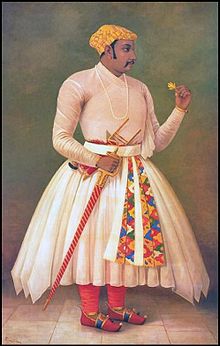Amar Singh I
| Amar Singh I | |
|---|---|
| 13th Maharana of Mewar | |
 Painting of Maharana Amar Singh I by Raja Ravi Verma | |
| 13th Maharana of Mewar | |
| Reign | 19 January 1597 – 26 January 1620 |
| Coronation | 19 January 1597 Udaipur, Rajasthan, India |
| Predecessor | Maharana Pratap |
| Successor | Karan Singh II |
| Born | 16 March 1559 Chittor Fort, Rajasthan |
| Died | 26 January 1620 (aged 60) Udaipur, Rajasthan |
| Spouse | Rani Amba , Rani Ashwini , Rani Ganga , Maharani Yamuna, Rani Kunti |
| Issue | Karan Singh II Surajmal (2/7 others) |
| House | Sisodia |
| Father | Maharana Pratap |
| Mother | Maharani Ajabde |
| Religion | Hinduism |
| Sisodia Rajputs of Mewar II (1326–1971) |
|---|
|
Maharana Amar Singh I, the Maharana of Mewar (16 March 1559 – 26 January 1620), was the eldest son and successor of Maharana Pratap of Mewar. He was the 13th Rana of Mewar dynasty of Sisodia Rajputs and ruler of Mewar from 19 January 1597 till his death on 26 January 1620. His capital was Udaipur.
Birth
Amar Singh was the eldest son of Maharana Pratap. He was born in Chittor on 16 March 1559, the same year, when foundation of Udaipur was laid by his grandfather, Udai Singh II.[citation needed]
Coronation
Amar Singh succeeded Maharana Pratap upon his death on 19 January 1597 and was the ruler of Mewar till his death on 26 January 1620.[1]
Battles
Battle of Dewar
After his coronation, Jahangir sent Asaf Khan and Parviz to attack Mewar; Amar Singh defeated them in the battle and they were forced to retreat, though it was a stalemate as soon Amar Singh had to accept Mughal suzerainty.
Defeat
Jahangir sent another army against Amar Singh in 1608 under Mahabat Khan in which though Mughals won but they could not make any decisive change to ground situation.[2]
Later an expedition was again sent under leadership of Prince Shah Jahan, which caused much damage to life and property of Mewar. Many temples were destroyed and several villages put on fire and ladies and children were captured and tortured to make Amar Singh accept surrender [2]
Peace treaty
Ultimately, after Mewar was devastated by Khurram's army, financially and in manpower, Amar Singh thought it was prudent diplomatic move to start negotiations with them and finally, entered into a treaty with Khurram (who negotiated on behalf of Jahangir) in 1615.[2]
In the treaty, it was agreed that Ruler of Mewar, will not be bound to present himself in person at Mughal court,[2] instead, a son or brother of the Rana would wait upon the Mughal Emperor and serve him.[3]. Thus, Prince Bhim (the younger brother of Amar Singh) served Shah Jahan in the deccan.[4] It was also agreed that the Ranas of Mewar would not enter matrimonial relations with the Mughals.[3]. Further, it was agreed that Mewar would have to keep a contingent of 1500 horsemen in the Mughal service.[5] Finally, it was agreed that the fort of Chittor would never be repaired. The reason for this last condition was that the Chittor fort was a very powerful bastion and the mughals were wary of it being used in any future rebellion.[3].
Later, when Amar Singh went to meet Jahangir at Ajmer, he was given a warm welcome by Mughal Emperor[2] and the territories around Chittor along with the Chittor Fort were given back to Mewar in 1616 by Jahangir, as goodwill gesture.[6] However, Udaipur remained the capital of Mewar State.[7]
Qualities
Amar Singh was loved by his pupils and chiefs for the qualities like bravery, leadership, valour, justice and kindness and it is believed that during a war with Mughal's he was believed to have shown great valour which gave him the title 'Chakraveer'.[1]
Death
Amar Singh died on 26 January 1620 at Udaipur and was succeeded by his eldest son Karan Singh II.[citation needed]
See also
Notes
- ^ a b Mathur 1994, p. 23.
- ^ a b c d e Pant 2012, p. 129.
- ^ a b c Chandra 2006, p. 123.
- ^ Nicoll 2009, p. 89.
- ^ Sharma, Sri Ram (1971). Maharana Raj Singh and his Times. p. 14. ISBN 8120823982.
- ^ Jahangir - Emperor of India - Encylopaedia Brittanica
- ^ http://udaipur.rajasthan.gov.in/content/raj/udaipur/en/about-udaipur/history.html#
References
- Pant, Ashok (31 August 2012), The Truth of Babri Mosque
- Nicoll, Fergus (2009), Shah Jahan, India: Penguin Books, ISBN 9780670083039
- Chandra, Satish (2006), Medieval India: From Sultanat to the Mughals (1206–1526), vol. 2, Har-Anand Publications
- Mathur, Pushpa Rani (1994), Costumes of the Rulers of Mewar: With Patterns and Construction Techniques
- Srivastava, Ashirbadi Lal (1969), The Mughul Empire (1526–1803 A.D.)
- Thorpe, The Pearson Guide To The Central Police Forces Examination, 2/E
